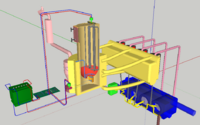No edit summary |
m (moved Generator to Electricity generator: This page discusses a electrical generator) |
(No difference)
| |
Revision as of 09:58, 10 June 2011
In electricity generation, an electrical generator is a device that converts mechanical energy to electrical energy, generally using electromagnetic induction. The reverse conversion of electrical energy into mechanical energy is done by a motor, and motors and generators have many similarities. The source of mechanical energy may be a reciprocating or turbine steam engine, water falling through a turbine or waterwheel, an internal combustion engine, a wind turbine, a hand crank, the sun or solar energy, compressed air or any other source of mechanical energy.

Template:Stub Rural Electrification Systems